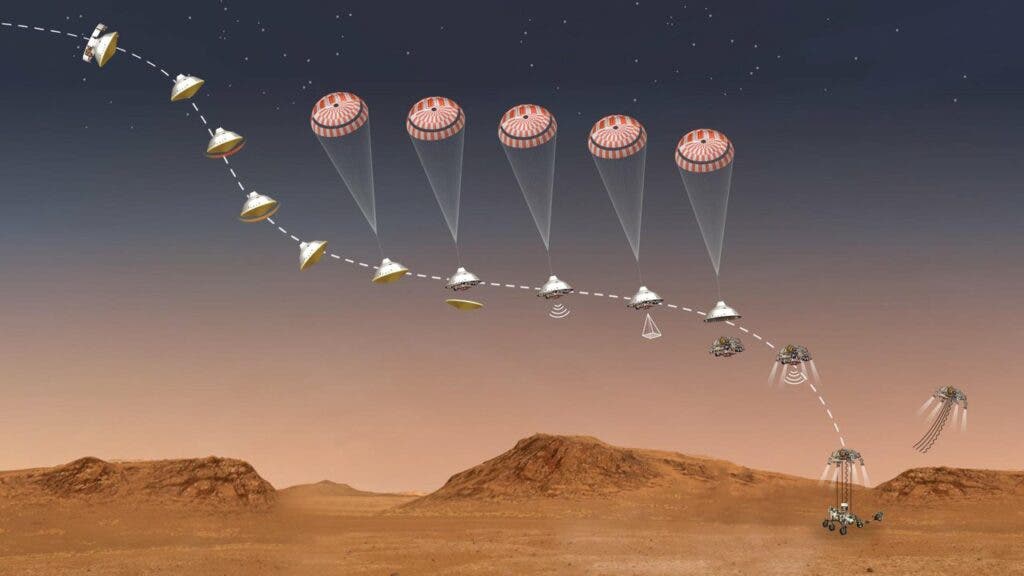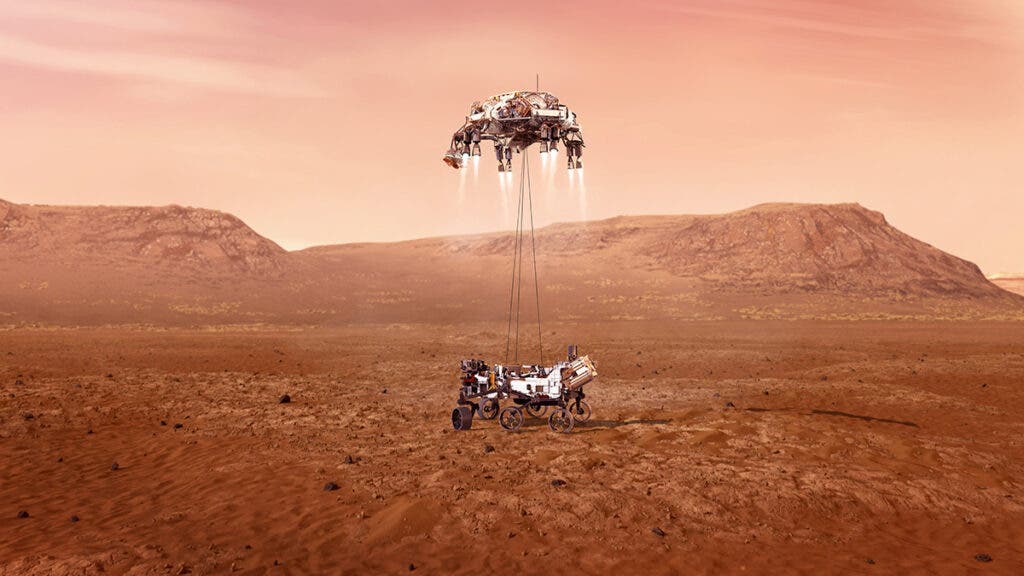Prior to the rover Curiosity, rovers were either reaching the surface of Mars via rocket-controlled landers or merrily bouncing their way along the surface nestled in airbags. However, the creation of the Mars Science Laboratory (MSL), later named Curiosity, presented a dilemma for engineers. How do you get a one-ton rover the size of a Volkswagen down safely?
While previously rovers utilized landers in which they would drive off, the new car-sized Curiosity presented a problem. Landers need ramps and larger rovers need larger ramps. Additionally, ramps can be one of an engineer’s worse nightmares. Since the first successful rover, Sojourner, landed on Mars in 1997, engineers have always been scared that a multi-billion dollar project could get to a planet some 40,000 miles away from Earth, only to have the rover snag a part on the lander ramp, essentially becoming a lander itself on top of another lander, rendering them both basically useless.
(Note: The microwave-sized Sojourner was not technically the first rover on Martian soil. That distinction belongs to the Russians’ Prop-M rover which was tethered to their Mars 2 and 3 landers. Since Mars 2 pancaked itself into the surface and Mars 3 lost communications with Earth because of a sand storm, neither rover was actually deployed).
Second problem: These larger landers and larger ramps would need more room. On a planet where the main inhabitants are rocks (and lots of them), finding clearance would be a big thorn in the side of those in charge of finding a place to land. Not only that, but the good science comes when you get near the rocky stuff, which would be hard if you had to park in lot BFE.
Third problem: Putting rockets on the bottom of a rover like it was done in earlier landers like Viking creates a stability problem. In the book “Curiosity” by Rod Pyle, he likens it to “balancing a bowling ball on a broomstick.”
This is one reason why Spirit and Opportunity utilized the airbag system. The airbag system is pretty much how it sounds. Prior to the rover landing on the ground, airbags would inflate bouncing them to land where they may. This was never a viable option for the much larger Curiosity rover. Airbags can only handle so much weight and 2,000 pounds went far beyond those limits. Also, airbags also create just another thing to get the rover caught on.
So a new landing system was needed. As Curiosity’s Chief Engineer, Rob Manning, told Pyle in his book, “We were thinking out of the box. In fact, we threw away the box. We were literally going through all possible ways to land this machine, trying to imagine every possible configuration, whether it made sense or not.”
When Manning and his team first conceived the idea, it didn’t exactly have a warm reception. After all, Curiosity would be coming on the heals of two high-profile failures by NASA with the Mars Polar Lander and the Mars Climate Orbiter missions of the “better, faster, cheaper” era of the space program. (In 2004, the Harvard Review actually published a report using this NASA method as the way NOT to do business).
So the idea was tabled…but not for long.
After time devising other strategies, it always ended up coming back to the sky crane. As harrowing as it sounded, it was also one of the best options to deliver the rover to the best destination.
The Sky Crane
Think of the sky crane portion of the descent stage as a kind of jetpack with eight engines which safely lowered the rover to the ground. The sky crane slows the robot down until it hovers over the surface, then slowly winches the rover down with nylon cords.
If you’ve ever seen heavy-lift Sikorsky Skycrane helicopters with cargo dangling beneath via cables, that’s the essence of the sky crane. In fact, the engineers who first devised the idea actually met with pilots and engineers of that bird for guidance. Unfortunately, due to the gravity differences between Mars and Earth, there wasn’t a real way to test the landing system. Yes, it was a do-or-die operation where the only real test HAD to work.
“We talked about it to no end. If this didn’t go right, there would be nowhere to hide because every joe six-pack on the street would be saying that they knew it wouldn’t work,” Adam Steltzner of NASA’s Jet Propulsion Laboratory, chief engineer for the Perseverance rover, told Astronomy. Stelzner’s team originally thought up the sky crane idea for Curiosity.
If all goes right, and the rover makes it safely to the ground, pyrotechnically activated blades cut the cords connecting it to the descent stage. The descent stage then flies off to make its own uncontrolled landing on the surface of the Martian surface a safe distance away from the rover.

Prior to all of that though, the machine has to make it through the atmosphere. The intense period called the entry, descent and landing (EDL) phase of the mission begins when the spacecraft reaches the top of the Martian atmosphere, traveling at about 13,200 miles per hour (5,900 meters per second). EDL ends about seven minutes later (known as the Seven Minutes of Terror) with the rover stationary on the surface. From just before jettison of the cruise stage 10 minutes before the craft hits the atmosphere, to the cutting of the sky crane bridle, the spacecraft goes through six different vehicle configurations and fires 76 pyrotechnic devices, such as releases for parts to be separated or deployed.
The parachute, which is 51 feet (almost 16 meters) in diameter, deploys about 254 seconds after entry, at an altitude of about 7 miles (11 kilometers) and a velocity of about 940 miles per hour (about 405 meters per second). About 24 more seconds after parachute deployment, the heat shield separates and drops away when the spacecraft is at an altitude of about 5 miles (about 8 kilometers), traveling at a velocity of about 280 miles per hour (125 meters per second).
As the heat shield separates, the Mars Descent Imager begins recording video, looking in the direction the spacecraft is flying. The imager records continuously from then through the landing. The rover, with its descent-stage “rocket backpack,” is still attached to the back shell on the parachute.
The back shell, with a parachute attached, separates from the descent stage and rover about 85 seconds after heat shield separation. At this point, the spacecraft is about 1.3 miles (2.1 kilometers) above the ground and rushing toward it at about 190 miles per hour (about 80 meters per second), 6,900 feet (2,100 meters) above the ground.
All eight throttleable liquid-fueled retrorockets on the descent stage, called Mars landing engines, would then begin firing for the powered descent phase. The rover’s wheels and suspension system, which double as the landing gear, pop into place just before touchdown. The bridle is fully spooled out as the spacecraft continues to descend, so touchdown occurs at the brisk walking speed of about 1.7 miles per hour (0.75 meters per second). When the spacecraft sensed the rover has touched down, those pyrotechnically-fired blades release the cords, and the descent stage can then fly away before impacting on the surface of Mars far away from the rover.
A notable difference between Perseverance’s EDL and Curiosity’s is the Lander Vision System (LVS). While Curiosity used radar to determine the distance to the ground, Perseverance utilized a whole new type of technology.
The LVS’s job determined the rover’s position, handling different possible terrain conditions, within an accuracy of about 130 feet (40 meters) in less than 10 seconds. It contains a downward-facing camera that took multiple images of the ground and an onboard computer – the Vision Compute Element (VCE) — which processed these images and spit out acceptable landing locations. After the camera powered on, the LVS used an initial five seconds to take three images and process them to calculate a rough position relative to the Martian surface. Then, using that initial location solution, it took additional images, processing them every second, deriving locations on a finer scale. The VCE sent a stream of these location calculations to the main rover brain, the Rover Compute Element.
Now what started as a hare-brained idea is seeming to becoming the norm for NASA.
“If you’re landing a rover on Mars, there’s no doubt this is the right way,” said Steltzner. “(For Curiosity) we certainly had questions about whether this really was a crazy thing to try to do. Had we missed a big thing? Was it totally wrong? Did all the pieces actually come together and work? We answered those questions.”



